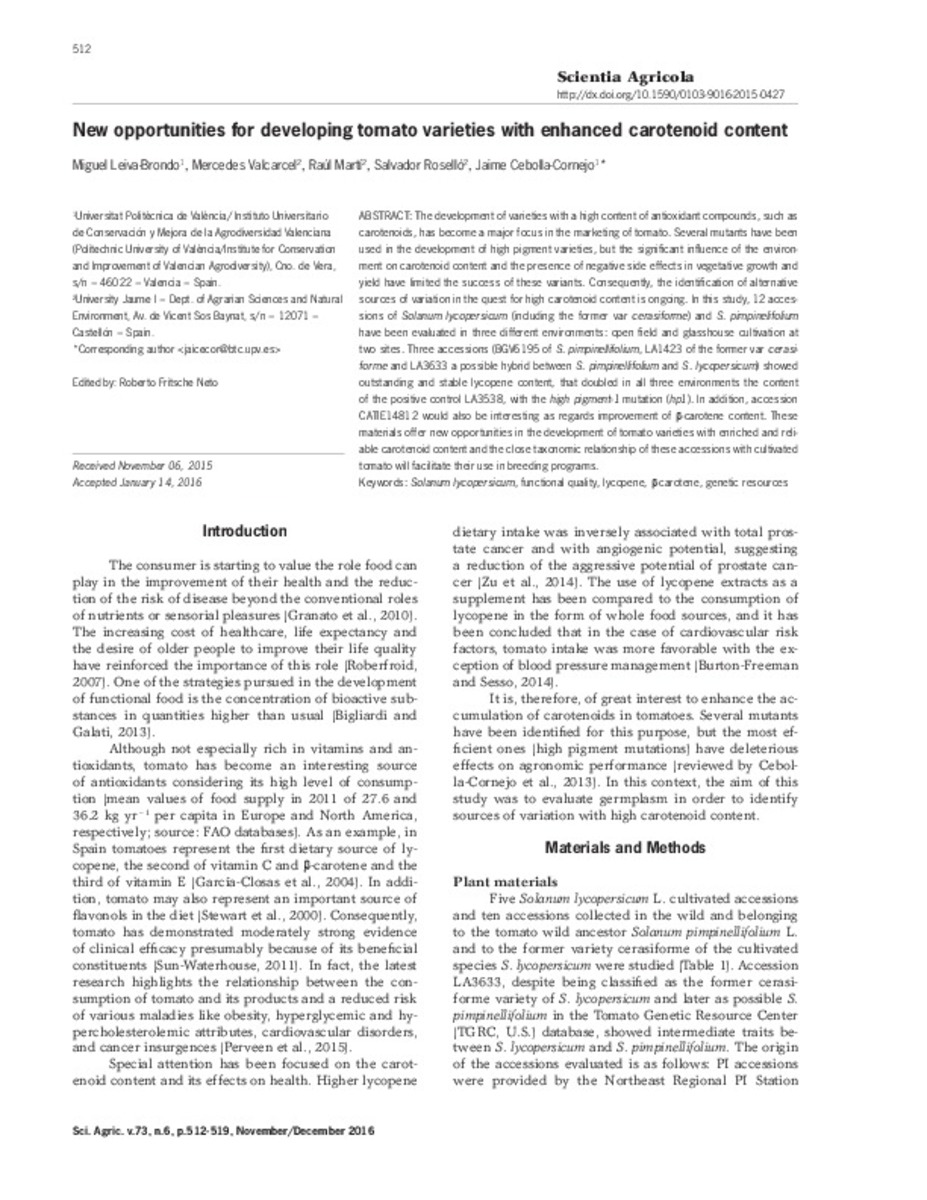Mostrar el registro sencillo del ítem
New opportunities for developing tomato varieties with enhanced carotenoid content
| dc.contributor.author | Leiva-Brondo, Miguel | |
| dc.contributor.author | Valcárcel, Mercedes | |
| dc.contributor.author | Martí, Raúl | |
| dc.contributor.author | Roselló, Salvador | |
| dc.contributor.author | Cebolla-Cornejo, Jaime | |
| dc.date.accessioned | 2016-11-09T12:08:38Z | |
| dc.date.available | 2016-11-09T12:08:38Z | |
| dc.date.issued | 2016 | |
| dc.identifier.citation | LEIVA-BRONDO, Miguel; VALCÁRCEL GERMES, Mercedes; MARTÍ RENAU, Raúl; ROSELLÓ RIPOLLÉS, Salvador; CEBOLLA CORNEJO, Jaime. New opportunities for developing tomato varieties with enhanced carotenoid content. Scientia Agricola (2016), v. 73, n. 9, pp. 512-519 | ca_CA |
| dc.identifier.uri | http://hdl.handle.net/10234/164328 | |
| dc.description.abstract | The development of varieties with a high content of antioxidant compounds, such as carotenoids, has become a major focus in the marketing of tomato. Several mutants have been used in the development of high pigment varieties, but the significant influence of the environment on carotenoid content and the presence of negative side effects in vegetative growth and yield have limited the success of these variants. Consequently, the identification of alternative sources of variation in the quest for high carotenoid content is ongoing. In this study, 12 accessions of Solanum lycopersicum (including the former var cerasiforme) and S. pimpinelifolium have been evaluated in three different environments: open field and glasshouse cultivation at two sites. Three accessions (BGV6195 of S. pimpinellifolium, LA1423 of the former var cerasiforme and LA3633 a possible hybrid between S. pimpinellifolium and S. lycopersicum) showed outstanding and stable lycopene content, that doubled in all three environments the content of the positive control LA3538, with the high pigment-1 mutation (hp1). In addition, accession CATIE14812 would also be interesting as regards improvement of β-carotene content. These materials offer new opportunities in the development of tomato varieties with enriched and reliable carotenoid content and the close taxonomic relationship of these accessions with cultivated tomato will facilitate their use in breeding programs | ca_CA |
| dc.format.extent | 8 p. | ca_CA |
| dc.format.mimetype | application/pdf | ca_CA |
| dc.language.iso | eng | ca_CA |
| dc.publisher | Universidade de Sao Paulo | ca_CA |
| dc.relation.isPartOf | Scientia Agricola (2016), v. 73, n. 9 | ca_CA |
| dc.rights | Atribución-NoComercial-SinDerivadas 4.0 España | * |
| dc.rights.uri | http://creativecommons.org/licenses/by-nc-nd/4.0/ | * |
| dc.subject | Solanum lycopersicum | ca_CA |
| dc.subject | Functional quality | ca_CA |
| dc.subject | Lycopene | ca_CA |
| dc.subject | β-carotene | ca_CA |
| dc.subject | Genetic resources | ca_CA |
| dc.title | New opportunities for developing tomato varieties with enhanced carotenoid content | ca_CA |
| dc.type | info:eu-repo/semantics/article | ca_CA |
| dc.identifier.doi | http://dx.doi.org/10.1590/0103-9016-2015-0427 | |
| dc.rights.accessRights | info:eu-repo/semantics/openAccess | ca_CA |
| dc.relation.publisherVersion | http://www.revistas.usp.br/sa/article/view/121816 | ca_CA |
Ficheros en el ítem
Este ítem aparece en la(s) siguiente(s) colección(ones)
-
CAMN_Articles [566]








